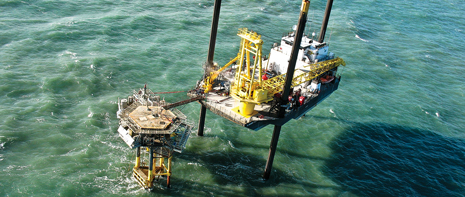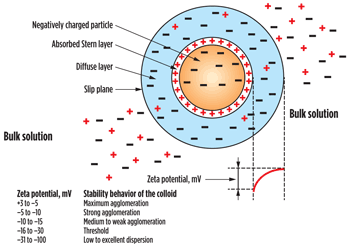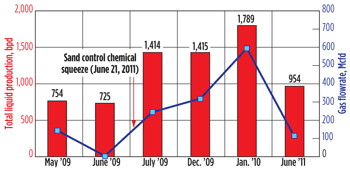Chemical treatment maximizes sand-free flowrate in Gulf of Mexico through-tubing application
By modifying the zeta potential of the formation particles, the non-resin treatment creates an ionic attraction that can eliminate sand and fines migration, and often reduces watercut.
TIM WALKER and ENOS FANGUE, Energy XXI; RON VAN PETEGEM and DAN JOHNSON, Weatherford International By modifying the zeta potential of the formation particles, the non-resin treatment creates an ionic attraction that can eliminate sand and fines migration, and often reduces watercut.
Sand production is a persistent challenge that reduces flowrates and can degrade equipment. In both remedial and primary sand control applications, a new chemical treatment that can be bullheaded through the production tubing is providing a unique, highly effective solution to the costly problem. The non-polymer, non-resin sand and fines control treatment uses a patented chemistry to increase the maximum sand-free rate (MSFR) by creating an ionic attraction between sand particles and fines without lowering relative permeability. After using the new chemistry in a remedial sand control treatment, Energy XXI achieved a significant performance response. Through June 2011, the treated Gulf of Mexico well has produced at two to three times its previous MSFR with no sand or fines production. Total accumulated production over this time interval is about 830,000 bbl. ALTERING THE ZETA POTENTIAL Weatherford’s SandAid chemistry works by modifying the zeta potential of the formation particles. This modification creates an ionic attraction that stops migration but allows adaptation to changes in formation stresses. Results include an increase in the MSFR, elimination or reduction of fines migration and reduced watercut in some reservoirs. The active ingredient of the zeta potential-altering chemistry is an inner salt of a very low-molecular-weight polymer. When added to the base fluid, it disperses and rapidly coats any metal oxide substrate, such as sandstone, Fig. 1. It also contains a penetrating alcohol to disrupt water layers that may coat solid surfaces in the formation. To create the strongest ionic attraction, the zeta potential needs to be as close as possible to 0 mV. With sandstones, the chemistry can repeatedly achieve a zeta potential of −1 to −6 mV; for coal, even lower values can be achieved. Because the chemistry works on any anionic substrate, it modifies the zeta potential of most fines. This reduces or stops fines migration and prevents or significantly reduces near-wellbore damage caused by fines. This fines-control effect enables a better contribution from the entire interval and can increase the productivity index. The zeta potential-altering chemistry itself is mostly cationic and adsorbs to anionic substrates. After the chemicals are adsorbed, the formation is mostly cationic, so no additional chemical is adsorbed into the treated formation. As a result, adding to the chemical volume pumped results in deeper treatments, not a thicker coating.
SAND CONTROL CAPABILITIES The chemical treatment allows the formation to remain ductile. Because it is not a bonding agent or a glue-type resin but instead uses ionic attraction, the sand particles have relative movement and can adapt to stress changes or even re-agglomerate if dislodged. Often, when near-wellbore stresses change due to drawdown forces, reservoir depletion or other downhole conditions, resin-based systems may not provide sufficient unconfined compressive strength to overcome these stress changes and may crack and lose their bonding. In such a case, the well can produce sand, but the failing resin can also reduce permeability near the wellbore and contribute to fines creation. With resin-based systems, the over-flush must follow the path of the resins and displace the resins out of the pore space. Under-displaced resins can result in up to 100% loss of permeability. To increase the probability that the over-flush displaces the resin into the formation and out of the formation pore space, the interval length is normally limited to 10–15 ft. Longer intervals require additional treatments. With the sand conglomeration treatment, the preference is to over-displace—in this case, to ensure a deeper treatment. If the treatment is not over-displaced, then the excess is simply produced out. The treatment can be mixed with a variety of fluids and has been applied with potassium chloride-based brines, formation water and seawater. It can also be foamed or mixed with power-law fluids. Not all formation water or brines are suitable, and there are some limitations to the maximum allowable total dissolved solids. Fluids are verified for compatibility with the reservoir to avoid scaling, clay swelling and emulsification. In most cases, 2%–6% potassium chloride is a good base fluid to use. In all cases, the base fluids must be filtered with an absolute filter system. When mixed with a Newtonian carrier fluid, the treatment behaves as a Newtonian fluid. This ensures good injection, and, in most cases, simple rate diversion for longer intervals can be used. Mixing with a thixotropic power-law fluid enables relatively simple diversion techniques and effective treatment of very long intervals. In fact, there is no limitation on the length of the treatment interval, but for practical reasons diverter tools are sometimes required. The decision to use diverter tools is driven by the maximum allowable pump rate and by the formation fracture pressure. As much as 115 ft of perforations have been treated in a single flush without the use of any diverter tools. In addition, the treatment exhibits very low risk to the reservoir; in lab conditions, no reduction in permeability has been observed. Field data support this finding. INITIAL APPLICATIONS The first field trials were performed in Romania in January 2008. Since then, IOCs, NOCs and independents have used it successfully in a range of applications. In almost all cases, the treatments have been bullheaded down the production tubing, though in some cases it has been delivered through a dedicated work string or coiled tubing. Success with the system has led to ongoing preparations for remedial treatments in several deepwater wells including both dry and subsea trees. The placement flexibility of the system is illustrated by one case in which the operator considered bullheading a treatment through the flowline into a subsea well. Initially, the treatment was mainly used to increase the MSRF in wells where conventional methods were deemed too costly, where through-tubing gravel-pack tools would not be suitable, or where there was otherwise insufficient performance gain. Many of these wells had a history of sand production. Experience with the system’s advantages led to new applications. Isolated pockets of oil or gas in existing wells are being produced by simply perforating (in many cases through multiple strings of pipe) and treating the zone with the new system. This enables the production of significant reserves that would otherwise be difficult or very costly to produce. In one such case, an operator in the GOM repurposed a well by perforating through several strings of pipe and treating it for use as a source well for lift gas. In yet another case for an operator in West Africa, sand production caused failure of the electrical submersible pump, forcing the well to be shut in. The operator decided to do a workover and install a gravel pack, but it failed after about four months of production. When the well was worked over in December 2010, a treatment using the new sand control chemistry was performed. Through June 2011, the well has produced sand free at rates higher than what the gravel-pack workover had achieved. Treatments have also been successful in controlling fines migration to prevent plugging of gravel and frac packs. ENERGY XXI APPLICATION A GOM well operated by Energy XXI had suffered increases in both sand and water production. When the well’s performance initially began to decline, sand management procedures led to a decision to choke production back, resulting in an MSFR of about 725 bpd of total liquid on gas lift. Several options were considered to increase the MSFR, including a workover with a gravel-pack or frac-pack installation, a through-tubing gravel/frac pack, and chemical sand control techniques. The workover was deemed too costly and, because of the existing completion configuration, a through-tubing gravel/frac pack was eliminated as a viable option. Several chemical sand control solutions were considered, including resins. The sand conglomeration system was selected because the treatment could be mixed with seawater and simply bullheaded down the production tubing. In addition, the system posed a very low risk to the reservoir because it exhibited no reduction in permeability during core-flood testing. Design considerations. Design of the sand conglomeration job was similar to that of a conventional matrix treatment. A qualifying consideration was lithology. Because the zeta potential-altering chemicals require an anionic substrate such as sandstone, the treatment is not suitable for cationic formations such as carbonate reservoirs. The matrix treatment works on all anionic particles. As a result, particle size distribution (PSD) or sieve analyses are not required. This is an advantage in existing wells or fields where PSDs are sometimes obtained from produced/bailed sand samples and may not be representative of the actual formation. While the effect of sand-size distribution on the achievable MSFR is not fully known, it has very little impact on the design of the job. In the GOM application, there was no sand or core sample available on which to do a representative PSD or sieve analysis. The design of the existing completion typically determines the placement method. Often the zone of interest can be isolated, in which case the treatment can be bullheaded down the production tubing. In other cases, coiled tubing is used. For the GOM well, only a single zone was connected to the production tubing. Other treated wells vary from single-selective completions to dual completions with six or more zones. After the sand was bailed from the area across the perforations, the treatment was bullheaded down the production tubing. Before the treatment, standard tubing movement and hydraulic analysis were performed to predict and confirm that no adverse effects on the completion would occur. The gas lift valves were left in place during the treatment. Sixteen feet of perforations were treated simply by bullheading the chemicals down the production tubing. No diverter tools were used. Permeability and porosity were considered to determine the total volume and concentration of the chemical treatment, although these are typically not a limiting factor. Wells have been treated with permeability ranging from a few millidarcies to several darcies. Permeability may impact the designed treatment rate and sometimes the concentration of the treatment chemicals in relation to the base fluid. Pump rate, another design consideration, ranged 3–5 bbl/min. Most treatments are performed through a simple rate diversion, which implies that the pump rate must be sufficiently high to allow the fluids to enter all producing portions of the zone being treated. With rate diversion, the portions of the zone with the highest permeability receive the deepest treatment.
Seawater was selected as the base fluid, mainly for logistical reasons related to the small size of the work platform. The seawater was filtered with a 2-micron absolute (beta 1,000) filter system. Treatment results. Following the treatment in mid-2009, the well was brought on production and monitored through a test separator for several weeks. During the initial stages of the cleanup period, small quantities of fine sand were observed. These were mostly a result of residual sand in the tubing. Within 24 hours, all traces of sand production stopped and no further sand production has been observed. Another noticeable fact was that for the first two months after the treatment, the well produced without gas lift, whereas gas lift had been required prior to the treatment. The well flowed for six months at about double its pre-treatment MSFR, Fig. 2. In January 2010, the well was opened up further and flowed at 1,789 bpd, almost 2½ times the original MSFR, on an 83% choke without sand production. The well was flowing sand free at the 12-month mark and had produced in excess of 500,000 bbl of liquid. To date, the well has flowed sand free for almost 24 months at flowrates varying from 730 bpd to 1,789 bpd for an approximate cumulative sand-free production of 785,000 bbl from 16 ft of perforations.
|
- Advancing offshore decarbonization through electrification of FPSOs (March 2024)
- What's new in production (February 2024)
- Subsea technology- Corrosion monitoring: From failure to success (February 2024)
- Prices and governmental policies combine to stymie Canadian upstream growth (February 2024)
- U.S. operators reduce activity as crude prices plunge (February 2024)
- U.S. producing gas wells increase despite low prices (February 2024)





